Modal Interchange: Crafting Rich Harmonies with Borrowed Chords
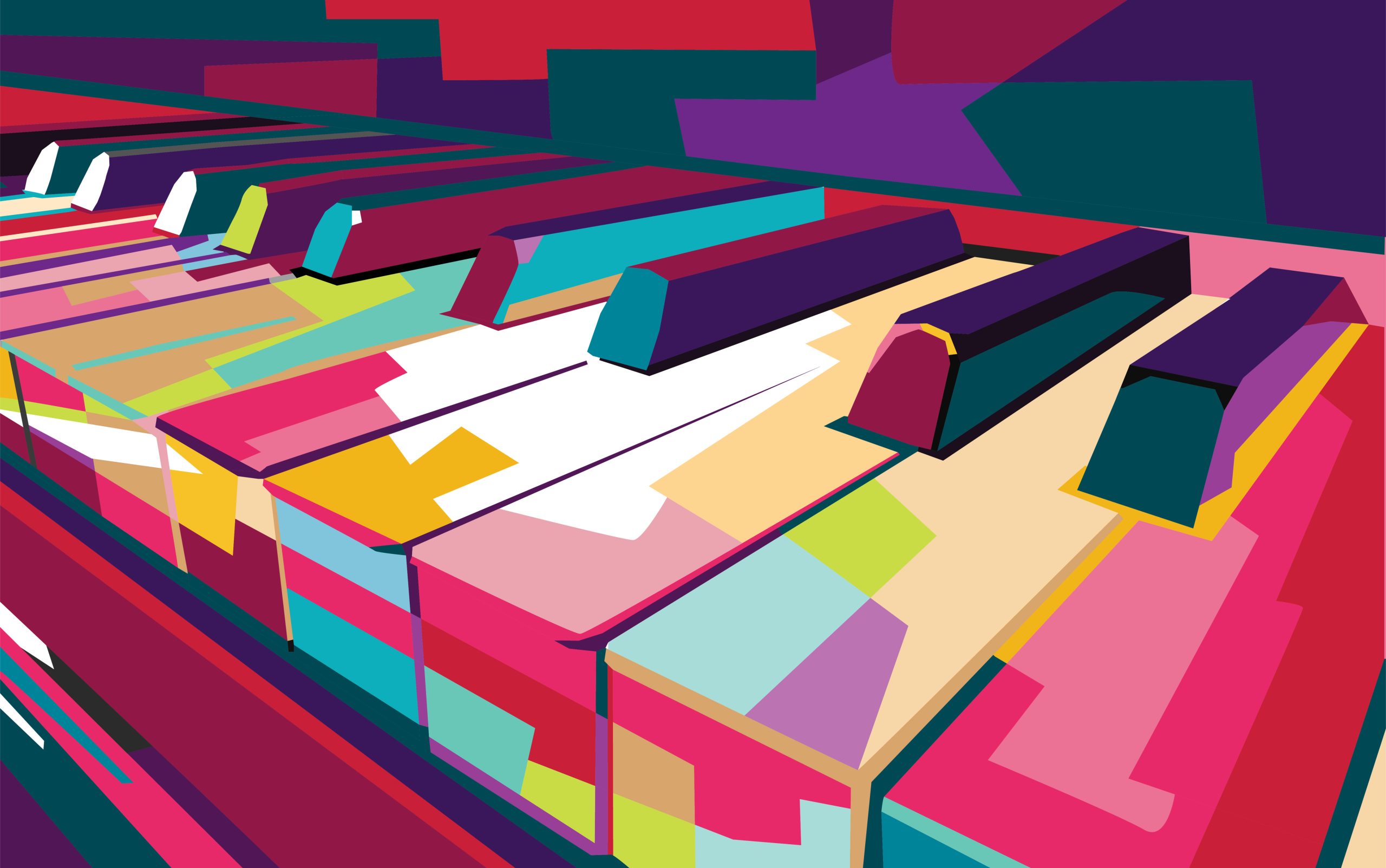
Now that you’ve got a good grasp of the major scale and each of its modes, the next obvious step is to experiment playing with and combining these scales together. Welcome to the world of modal interchange, a technique that adds a splash of color and harmonic variety to music by borrowing chords from parallel modes. It’s a music theory concept that many composers use to create unexpected moods, enrich chord progressions, and bring their music to life. Let’s dive deeper into this fascinating concept and learn how you can apply it to your compositions.
Understanding Modal Interchange
Think of modal interchange, sometimes called modal mixture, as introducing different shades of colors onto a fabric. It enriches chord progressions and brings unexpected moods by borrowing chords from parallel modes, thus introducing harmonic variety and color to music.

So, how does this work in a chord progression? Imagine a composer working in the key of C major, who decides to borrow some chords from C minor. The result? A more complex and captivating harmonic progression, which keeps the listener engaged and intrigued. These brief deviations have the potential to evoke profound emotional responses, making the music more engaging and memorable.
Parallel Keys and Borrowed Chords
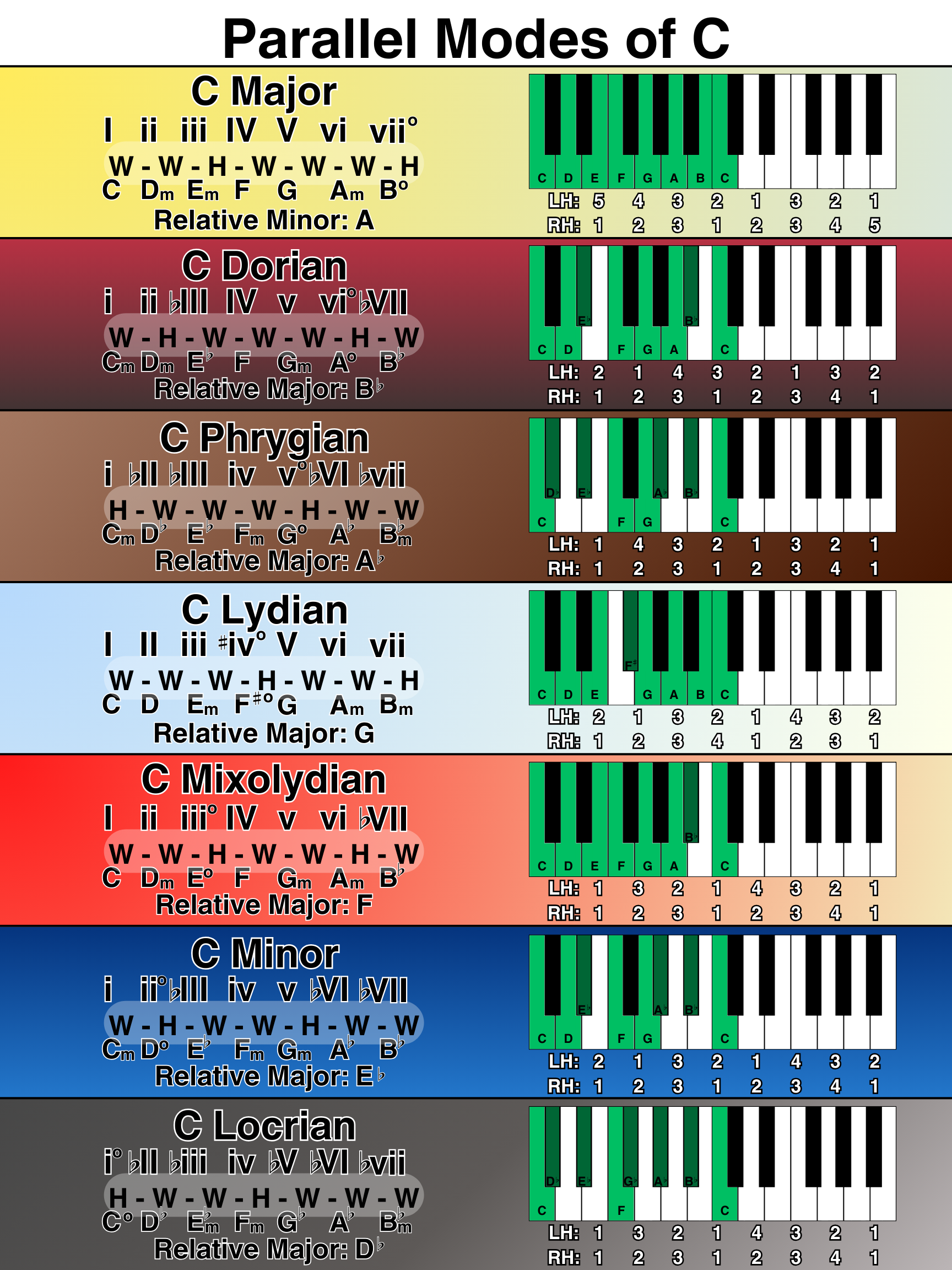
Parallel keys are keys that share the same root note but have different scales and tonalities, such as a major key and its parallel minor. This is like two different paths originating from the same point; they may start from the same root note but lead to different musical landscapes, ultimately reaching their destination key.

As indicated by the name, borrowed chords are derived from parallel keys, which, despite sharing the same root note, possess different scales and tonalities. For instance, in a composition in C major, you might suddenly encounter an Fm chord borrowed from the parallel mode of C minor. This unexpected detour can be followed by a dominant chord to create a strong resolution, adding a surprising twist to the harmonic journey.
Over time, you’ll get used to some common borrowed chords that are often used, like the I – iv progression in our example above. It’s called the minor plagal cadence, and its perhaps the most popular progression that uses borrowed chords as its used in many popular songs like creep by Radiohead for example.
Major and Minor Scales
The most common example you’ll hear of modal interchange is between major and minor, including the harmonic minor. With their contrasting tones – joyful and bright for major scales, melancholic for minor scales – they offer a wide array of chords for creating diverse chord progressions.

Just as spices enhance a dish, borrowed chords add contrast, depth, and unique flavors to chord progressions. For example, in the key of C major, chords can be borrowed from the parallel mode of C minor to introduce diversity to the chord progression. These borrowed chords can harmonize non-diatonic notes in the melody and bring excitement by altering the mood through borrowing from parallel keys.
Beyond Major and Minor: Other Modes
However, the scope of modal interchange goes beyond major and minor scales, encompassing the borrowing of chords from other modes like Dorian, Phrygian, and Lydian, thereby expanding harmonic possibilities. Each of these modes has its unique interval structure, which influences the mood and character of the music.
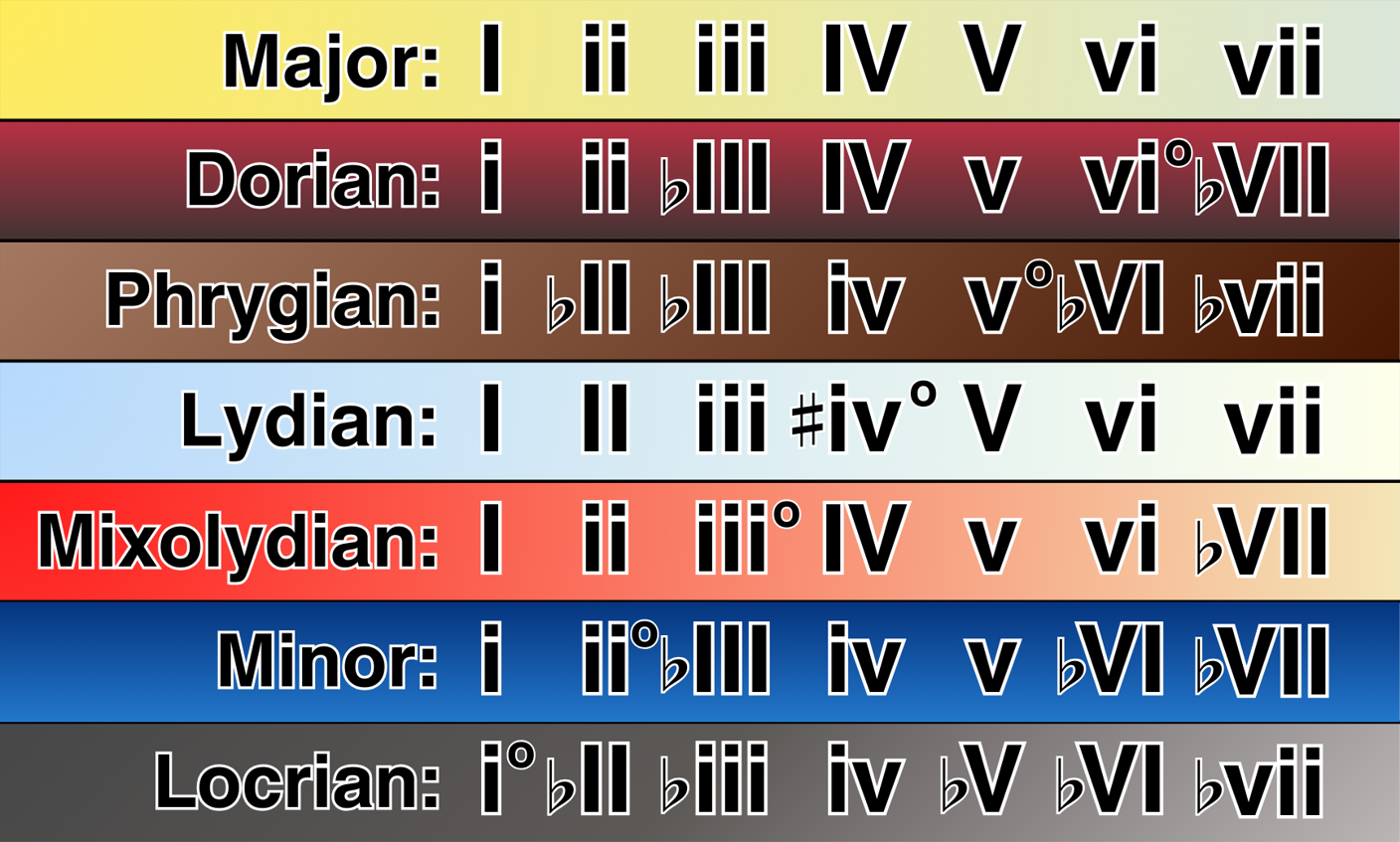
You should experiment mixing and matching with the rest of the parallel modes to see what intriguing harmonies you can create. You may not like the combinations you come up with every time. Like a change from a super bright mode like Lydian to a super dark mode like Phrygian might be too drastic of a change for your liking, but you’ll never know until you try it. Maybe you do like that sudden switch in brightness, and it’s a sound you couldn’t get from just switching between major and minor.
You’re also not limited to just the seven parallel modes of the major scale. You could switch between any number of parallel keys. Like switching from C major to C harmonic minor, C Phrygian Dominant, etc.
Making Chord Progressions with Modal Interchange
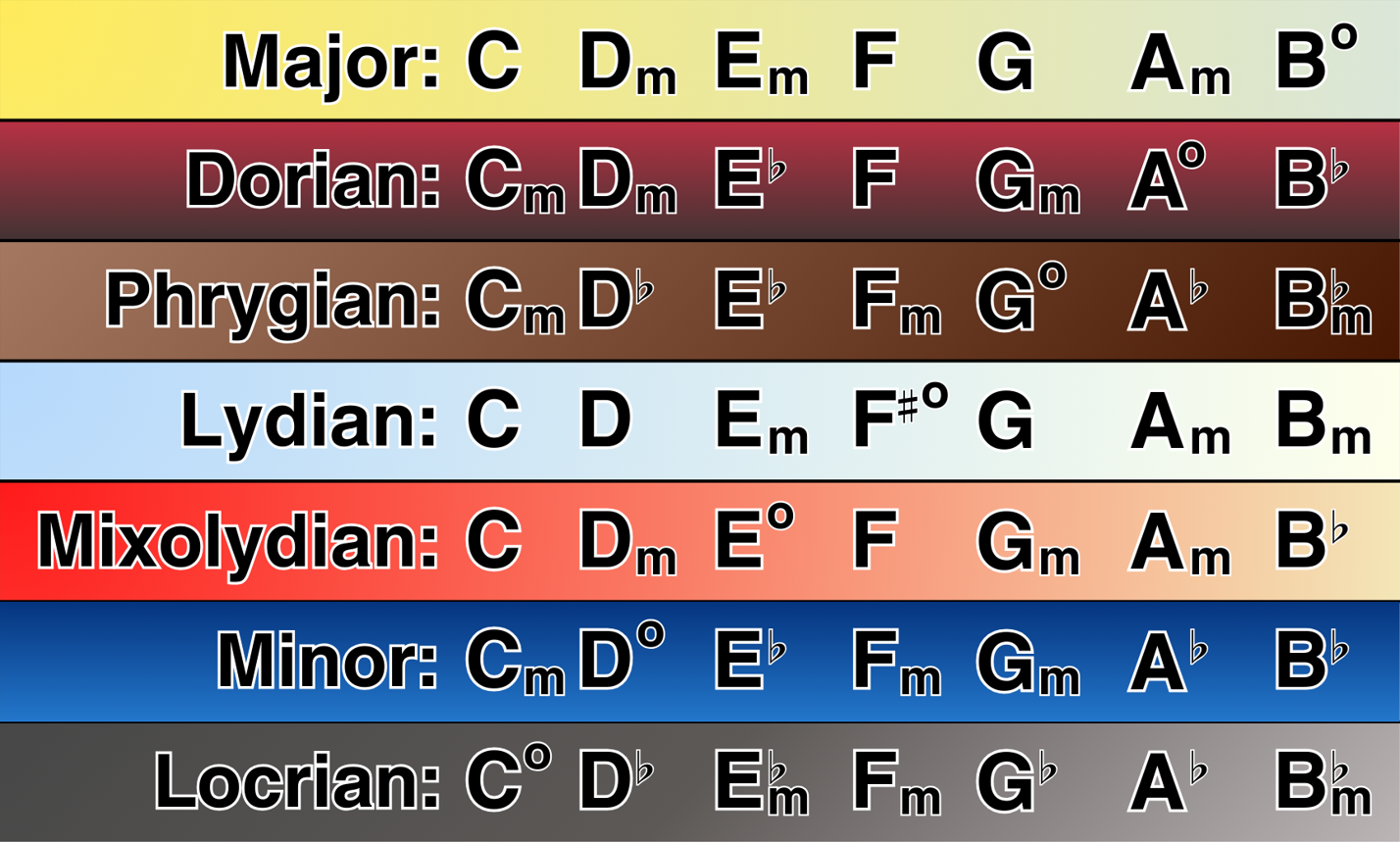
To start, let’s make a simple two chord progression with C as our tonic chord. Ask yourself, “What scales or modes can I use that have an C chord as their tonic chord?” You could play the C Ionian, Lydian, or Mixolydian mode over this chord. Now just pick any other random chord to be your second chord. Let’s say you picked F minor. The next step is to ask yourself, “What are the different parallel modes of C that use an F minor chord?” Remember, we wan to think in the context of C because it’s our tonal center. You could play C Aeolian, Phrygian or Locrian as they all have an Fm.
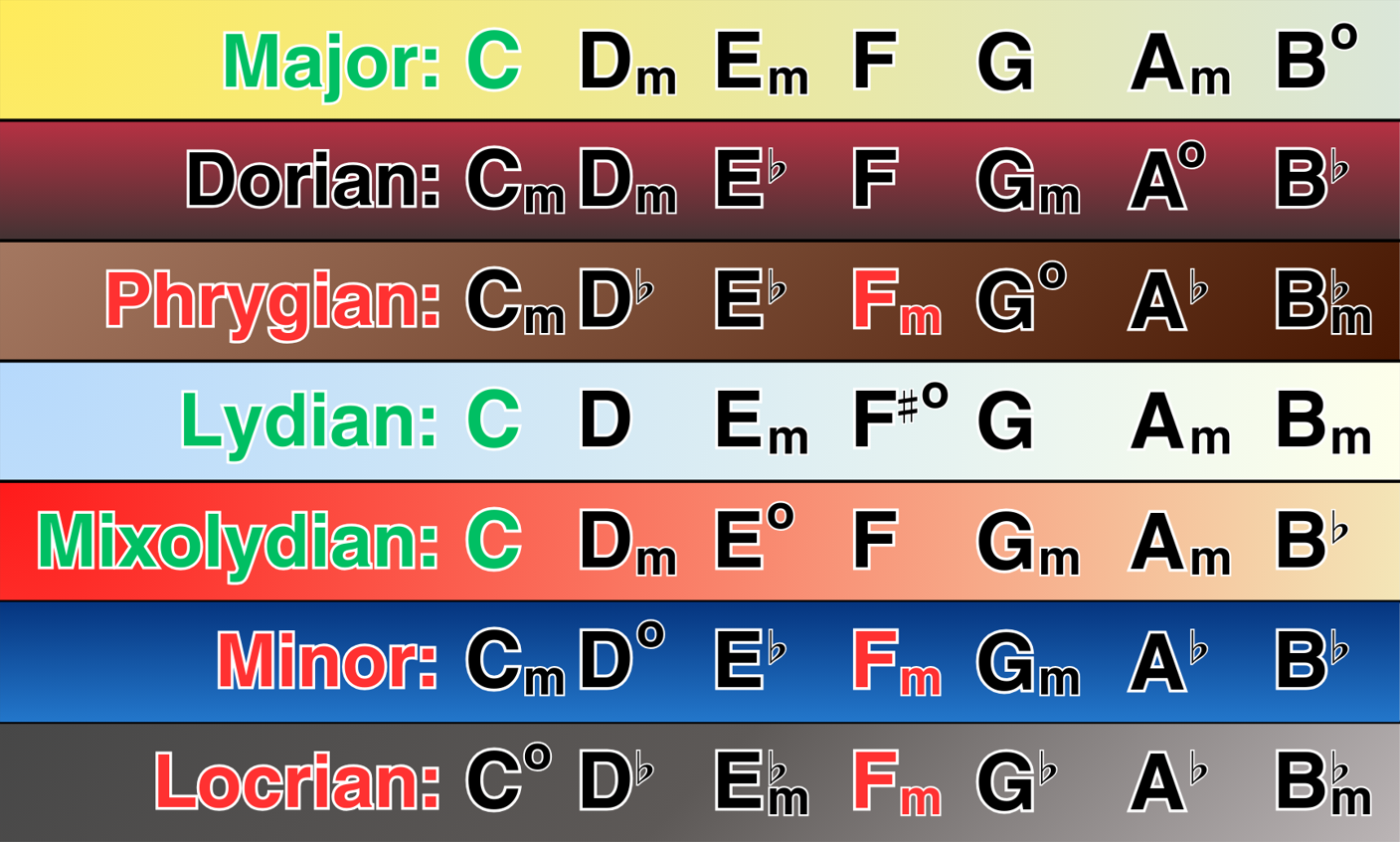
Making Melodies With Modal Interchange
So now you have the chord progression of C to Fm. For our example, let’s switch between C major and C minor as our two parallel modes. Whenever the C chord pops up, you’ll want to play the scale of C major over it. Whenever the Am chord pops up, you’ll want to play the E minor scale over it.
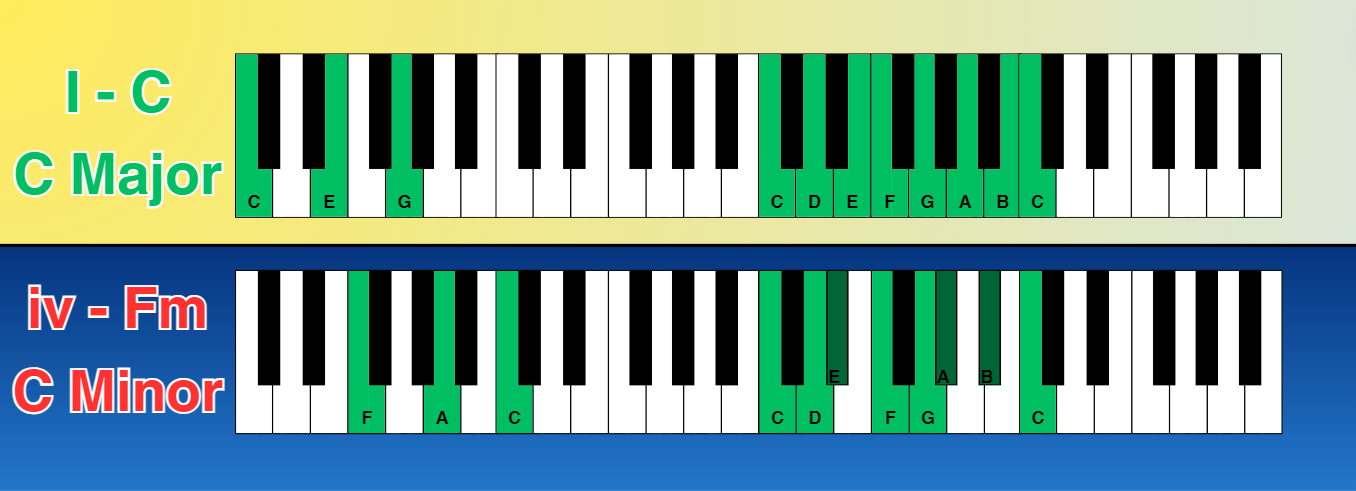
Start off with something simple like playing a C chord with your left hand and going up and down the C major scale with your right hand. Likewise, play an F minor chord with your left hand while you go up and down the C minor scale with your right hand. Just by doing this you’ll better get to hear the modal mixture going on and how these modes sound different from one another.
After a while, you can try and make more interesting melodies over each chord as you get more comfortable with your scales. Modal interchange is really good practice as switching between parallel scales on the fly helps you further see the relationships between the different modes.
Depending on how long you linger on a borrowed chord for, you have the opportunity to really bring in a brand new tonality into your music. But if a chord only pops up for a small period of time, modal mixture is a great choice to accommodate it while still keeping the same tonal center.
Practical Tips for Incorporating Borrowed Chords
Having delved into the concept and application of modal interchange, let’s now explore some practical strategies for integrating borrowed chords into your compositions. Borrowed chords can enrich a piece of music by:
- Broadening the harmonic vocabulary
- Offering supplementary notes that harmonize with and reinforce the primary tune or motif.
Use Borrowed Chords Sparingly
Borrowed chords are a powerful tool for adding interest and variety to your music. However, using them too frequently can make your tonal center unclear and make your music sound disjointed. Therefore, it is essential to maintain cohesiveness in the harmonic structure when incorporating borrowed chords. Use them to highlight specific moments or to create tension that can be resolved later in the piece.

For instance, a chord progression in C minor might typically follow this pattern: Cm – Fm – G7 – Cm. The chord progression borrows a chord from the parallel mode of C Major, substituting the Gm with a G7. The G7, being a dominant seventh chord, creates a strong sense of tension and anticipation in the listener, which is then resolved nicely when we return to the Cm.
Practice Voice Leading

Good voice leading can help maintain the flow of your music when introducing borrowed chords. Try to keep the movement between the notes in your chords as smooth as possible by avoiding large jumps.

Now, let’s improve the voice leading by using inverted chords. The progression might then become: C – Fm/Ab – G/B – C. In this revised progression, the bass line moves in a stepwise motion (C – Ab – B – C), producing a smoother and more cohesive sound.
Pivot Chords and Smooth Transitions
Pivot chords are key in facilitating seamless transitions between varying keys or tonalities. They are shared between the original key and the borrowed key, facilitating the smooth introduction of borrowed chords, thereby establishing a harmonic link between the two keys.

The effectiveness of a pivot chord in facilitating smooth transitions is attributed to its ability to gently transition the ear into the new key and enable a seamless shift between keys. Therefore, when employing modal interchange in your compositions, see if you can find a common chord between your modes to serve as a pivot chord to create smooth transitions between them.
While it’s a useful technique to look for a common chord between your two modes to serve as a pivot chord, it’s important to note that you may not always find one. Even without a common chord, there are other ways to create smooth transitions between modes.
Choose Borrowed Chords That Fit the Melody
When choosing which chords to borrow, consider using chords that don’t clash with your melody. Consider this simple melody below in the key of C major that prominently features the sixth note (A). Try creating a chord progression that complements it in the key of C major, and then experiment with incorporating some borrowed chords from C minor.

It’s advisable to steer clear of incorporating chords from C minor that include the flattened sixth note (Ab). This is because the A and Ab notes would clash and create dissonance. While it’s still possible to utilize a chord from C minor containing Ab, such as Fm, caution is needed to ensure that it doesn’t coincide with the occurrence of an A note in your melody.

Be mindful of the context and timing so that the clash between the A and Ab notes is intentional and adds a desired flavor to your musical composition rather than creating unwanted dissonance. Experimenting with the placement and duration of these chords can help you achieve a harmonically interesting and balanced result.
Make A Melody That Highlights The Change
Alternatively, you can design a melody or motif that transposes its notes to fit the new scale you’re in. For example, if you’re going to be switching from C major to C minor, try and come up with a melody that prominently features the third degree since the third degree gets flattened in the change from major to its parallel minor. By doing so, you can really hear the difference between the two scales and it creates a strong pulling effect between the two.

Even something small like arpeggiating a major chord and then arpeggiating to its parallel minor has such a distinct change. Get the listener familiar with the tonality of a melody, then alter it to fit the new scale you’re in. By following these strategies, you can incorporate borrowed chords into your melodies while maintaining musical cohesiveness.
Analyzing Modal Interchange in Music
Transcending genres, modal interchange can be found in various styles of music, including:
- Classical music, with its grandeur and complexity
- Jazz and blues, with their soulful and improvisational nature
- Rock and pop, with their pulsating rhythms and catchy melodies
Modal interchange weaves its magic across the musical spectrum, adding depth and interest to compositions in all genres.
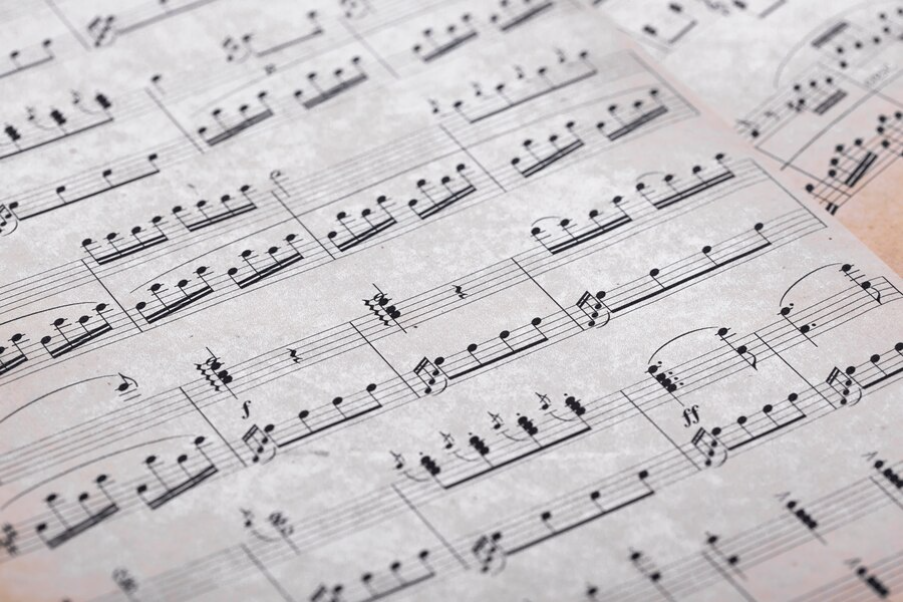
To spot modal interchange in a musical score, search for chords hailing from parallel major and minor scales, or annotations signifying the source mode of each borrowed chord. Developing your ear to discern borrowed chords and modal interchange is a skill that augments both your musical comprehension and improvisation abilities. So, the next time you listen to a piece of music, try to identify any borrowed chords. It’s a fun and rewarding exercise that greatly improves your musicianship.
Classical Music
In classical music, composers such as Gabriel Fauré have utilized modal interchange to infuse their works with harmonic intrigue and emotional depth. For instance, Fauré’s ‘Pavane’ features borrowed chords, which add a different layer of harmony and depth to the composition.
Modal interchange serves as a tool for these composers to introduce new and unique chord progressions, create tension and resolution, and expand the range of tonal colors and emotional expressions in their works. The unexpected harmonies brought about by modal interchange contribute to the emotional depth and complexity of classical compositions, providing a more nuanced and enriched emotional experience.
Rock and Pop Music
Rock and pop music are well-acquainted with modal interchange, where borrowed chords are employed to impart emotional resonance and carve out unique chord progressions. Take the song ‘Blue’ by LeAnn Rimes, for instance. It incorporates two secondary dominant chords and a major-two chord in its initial progression, adding a unique harmonic twist.
Renowned rock bands such as Radiohead often use modal interchange in their songwriting, adding layers of harmonic complexity to their music. By incorporating borrowed chords, they have crafted distinctive harmonic progressions, employing modal interchange and reharmonization techniques to produce intricate and surprising progressions that enhance the complexity and sound.
Modal Modulation
So far we’ve discussed modal mixture which is all about switching between the parallel modes of whatever key you’re in. However, what about shifting to the relative modes of your key instead? This would be an example of modulation. There’s different types of modulations, but we’re going to be looking at modal modulation.
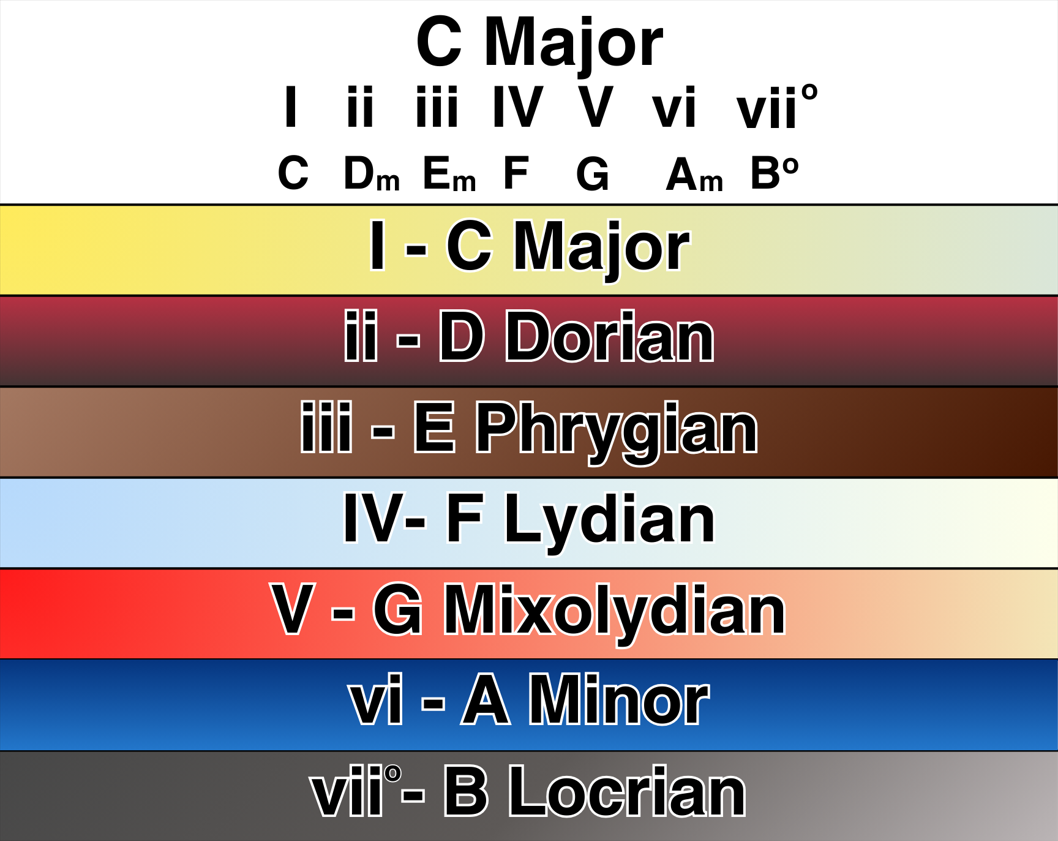
Modal modulation is the process of changing keys by switching to a relative mode. An example would be switching between C Major to A minor, as they’re both relative majors and minors of each other. This technique provides a unique effect, subtly shifting the tonal landscape of the music without causing a drastic change.
In order to make modal modulation work, you need to really lean into each mode that you’re in by highlighting that modes unique qualities. For example, let’s say you want to make a song where the verses are in D Dorian, but the chorus is in A minor. While you’re writing your verse in D Dorian, think of your D Dorian scale as you’re playing and try to highlight that raised sixth degree in your melodies. Use chords from D Dorian that use that sixth degree in a significant way like the IV chord (G major). Otherwise, it’s all just going to sound like A minor.
Key Takeaways
- Modal interchange introduces harmonic variety and emotional depth by borrowing chords from parallel modes, enabling composers to weave complex and captivating harmonic progressions that are attractive to the listener.
- Borrowing chords can be not just from major and minor scales but also from modes such as Dorian, Phrygian, and Lydian, which expands the possibilities for creating intriguing and diverse musical moods and textures.
- Practical application of modal interchange requires judicious use, involving strategic use of pivot chords for smooth key transitions and experimenting to add tension and color, enhancing the harmonic complexity of a composition.
Summary
In conclusion, modal interchange is a powerful tool that musicians can use to enrich their compositions, add complexity to chord progressions, and create unexpected moods. Whether it’s the joyful strains of major scales, the melancholic tones of minor scales, or the unique tonalities of other modes like the Dorian, Phrygian, or Lydian, the possibilities of modal interchange are vast and exciting. By incorporating borrowed chords, you can create a rich atmosphere to captivate your listeners. So, why not start experimenting with modal interchange today and explore the endless harmonic possibilities it offers?


